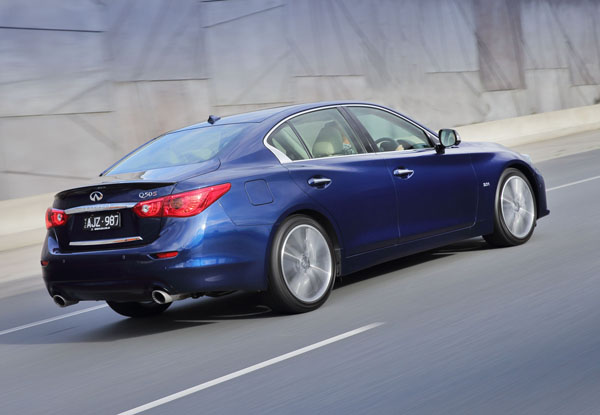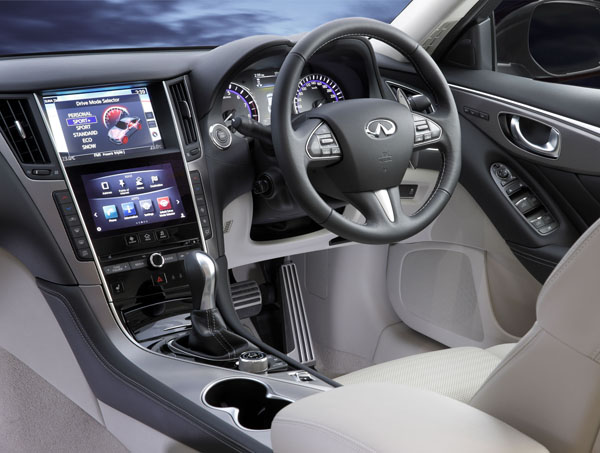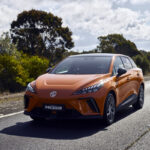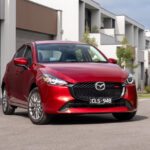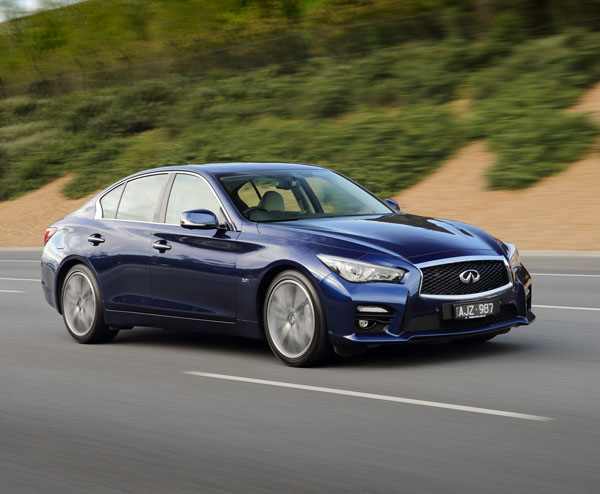 They say that imitation is the sincerest format of flattery so when Infiniti launched the first batch of its ‘Q’ cars in early 2014 and named them Q50 (for its mid-sized sedan), Q60 (coupe and convertible) and Q70 (large sedan) it was fairly obvious that the Japanese car maker was setting its sights high by imitating the BMW and Audi numbering format.
They say that imitation is the sincerest format of flattery so when Infiniti launched the first batch of its ‘Q’ cars in early 2014 and named them Q50 (for its mid-sized sedan), Q60 (coupe and convertible) and Q70 (large sedan) it was fairly obvious that the Japanese car maker was setting its sights high by imitating the BMW and Audi numbering format.
More realistically Infiniti’s main rival is likely to be its Japanese compatriot Lexus.
This week’s review car is the Infiniti Q50 and its chances of becoming a realistic competitor received a major boost at launch with price cuts in excess of $20,000 over the previous M37 sedan. It was given a mid-life upgrade in October 2016 highlighted by a new 3.0-litre V6 twin-turbo petrol engine as well as some chassis improvements.
STYLING
Overall, the new Q50’s styling is effectively untouched which makes sense because it’s one good looking car. Long and low-slung, it looks bigger than it is, and bigger than its rivals. It has a strong down-the-road presence, with lots of curves, angles and cutouts as well as a couple of design flourishes at the rear.
In line with their performance attributes the new twin-turbo 3.0tt Sport Premium and 3.0tt Red Sport variants get a bolder grille design featuring a waved mesh pattern surface and chromed surrounds. They also get larger (19-inch, others get 17-inch) alloy wheels that sit inside run flat tyres.
The Q50 Red Sport 400 also adds a black spoiler, sporty exhaust tips and red “S” badging.
A powered glass sunroof is standard in the Sport Premium and Red Sport models, and optional on all but the entry-level GT.
ENGINES / TRANSMISSIONS
Infiniti Q50 comes with plenty of engine choices, two of them turbo-petrol, one turbo-diesel as well as a naturally-aspirated petrol / electric hybrid.
The entry-level Q50 GT is powered by a 2.0-litre four-cylinder turbo-petrol engine that’s carried over from the previous model. It gets a minor performance tweak with power up by 5 kW to 155 kW but with torque unchanged at 350 Nm at 1500 rpm.
The diesel four has a capacity of 2.1 litres (although Infiniti calls it the 2.2d) with 125 kW and 400 Nm from 1600 to 2800 revs.
Both of these four-cylinder engines are shared with Mercedes-Benz because of the technical partnership between Infiniti’s parent company Renault-Nissan and Daimler.
The top of the range 3.0tt Sport Premium and 3.0tt Red Sport models each get the new high-performance 3.5-litre turbo-petrol V6 although they are in different levels of tune. In the Sport Premium it delivers 224 kW at 6400 rpm and 400 Nm of torque between 1600 and 5200 rpm. That increases to 298 kW and 475 Nm at the same revs.
Our test car came with the 3.5t S Premium petrol / electric hybrid engine powertrain with combined power of 268 kW and peak torque of 546 Nm at 1470 rpm. It has virtually instant acceleration due to the big torque electric motor.
The Q50 hybrid is also available with all-wheel-drive. All other models are driven through the rear wheels.
The only transmission is a seven-speed automatic, with a manual shift mode. A Drive Sport (DS) mode allows the driver to vary the shift pattern with automatic up-and-down shifting at higher rpm. All models above GT come with paddle shifters.
Direct Adaptive Steering (DAS) is standard across the Q50 range and all drivers to adjust the steering system’s levels of response and feel. There are six options: Personal, Standard, Snow, Eco, Sport and Sport+.
SAFETY
Infiniti Q50 achieves the maximum five-star ANCAP rating with six airbags; ABS brakes with brake assist and brakeforce distribution; traction and stability control; IsoFix child seat anchors; front and rear parking sensors; tyre pressure monitoring; approaching vehicle sound for pedestrians; around view camera; cruise control with speed limiter; and moving object detection.
All models above GT also get adaptive cruise control; lane departure warning and prevention; blind spot warning and intervention; predictive forward collision warning and emergency braking; and back-up collision intervention.
INFOTAINMENT
The Infiniti InTouch system is standard across the Q50 range. It has a dual-screen layout, with an 7.0-inch upper and 8.0-inch lower colour displays. The upper screen seven-inch covers the satellite navigation and camera; the lower one displays everything else including drive modes, audio and telephone.
Q50 GT gets a basic six-speaker audio system, all others graduate to a premium 14-speaker Bose audio system with Bose’s Centrepoint simulated surround technology, AudioPilot noise compensation and Advanced Staging technology.
DRIVING
The front seats are large and support well. The rear seats have legroom that’s about average for rear-drive cars in this class. Rear headroom will be marginal for anyone at or above average height.
Boot size in all models except for the Hybrid is a decent 500 litres. The Hybrid loses 100 litres due to the batteries and also misses out on the fold-down backrests used on the other Q50s.
The steering uses Infiniti’s electric actuation system in which the steering rack is moved by actuators. The different modes on the adaptive steering system can be customised and are definitely noticeable. Feel is different to that of normal steering, but not to a great extent. There’s high grip and the Infiniti provides a feeling of added security if you mistakenly take a bend too fast.
While the major selling points with hybrid vehicles are fuel economy and lower emissions we love the instant response you get when you hit the accelerator pedal because electric power means torque is there from zero revs.
Listed combined fuel consumption of 6.8 litres per 100 kilometres from ‘our’ rear-wheel drive hybrid is 0.5 below that from the Q50 GT with its 2.0-litre turbo-petrol. We averaged around 7.8 L/100 km in our week behind the wheel of the 3.5t S Premium Hybrid.
Ride comfort is good and noise reduction is excellent, the latter very reminiscent of that provided by Infiniti’s biggest rival, Lexus.
SUMMING UP
Significant price cuts from the previous Infiniti ‘M’ cars have the Q50 starting around the mid-$50,000 mark. It’s more fuel efficient than most of its competitors, has an excellent road presence, plenty of tech features, four-year warranty — and is great fun to drive.
Although the Infiniti in Australia doesn’t carry the badge status of the big three European brands, or even of Lexus, we’d certainly recommend that anyone looking to buy a prestige mid-sized sedan – and can live with the fact that most people won’t recognise the badge – should check out the Q50 before making their final decision.
AT A GLANCE
MODEL RANGE
Q50 2.0t GT 2.0-litre turbo-petrol four-door sedan: $53,900 (automatic)
Q50 2.0t S Premium 2.0-litre turbo-petrol four-door sedan: $61,900 (automatic)
Q50 2.2d GT 2.1-litre turbo-diesel four-door sedan: $54,900 (automatic)
Q50 2.2d S Premium 2.1-litre turbo-diesel four-door sedan: $62,900 (automatic)
Q50 3.5h S Premium 3.5-litre petrol / electric hybrid four-door sedan: $72,900 (automatic)
Q50 3.5h S Premium 3.5-litre petrol / electric hybrid AWD four-door sedan: $74,900 (automatic)
Q50 3.0tt Sport Premium 3.0-litre twin turbo-petrol four-door sedan: $69,900 (automatic)
Q50 3.0tt Red Sport 3.0-litre twin turbo-petrol four-door sedan: $79,900 (automatic)
Note: These prices do not include dealer or government charges. Contact your local Infiniti dealer for drive-away prices.
SPECIFICATIONS (Infiniti Q50 3.5h S Premium 3.5-litre turbo-petrol / electric hybrid four-door sedan)
ENGINE:
Capacity: 3.498 litres
Configuration: V6
Maximum Power: 268 kW
Maximum Torque: 547 Nm
Fuel Type: Petrol 98RON
Combined Fuel Cycle (ADR 81/02): 6.8 L/100km
CO2 Emissions: 159 g/km
DRIVELINE:
Seven-speed automatic
DIMENSIONS, WEIGHT AND CAPACITIES:
Length: 4800 mm
Wheelbase: 2800 mm
Width: 1820 mm
Height: 1445 mm
Turning Circle: 11.2 metres
Kerb Mass: 1775 kg
Fuel Tank Capacity: 70 litres
BRAKES:
Front: Ventilated disc
Rear: Ventilated disc
STANDARD WARRANTY:
Four years / 100,000 km




